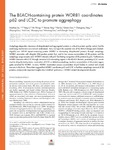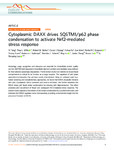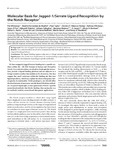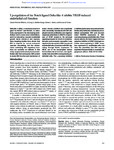The BEACH-containing protein WDR81 coordinates p62 and LC3C to promote aggrephagy
| dc.contributor.author | Liu, X | |
| dc.contributor.author | Li, Y | |
| dc.contributor.author | Wang, X | |
| dc.contributor.author | Xing, R | |
| dc.contributor.author | Liu, K | |
| dc.contributor.author | Gan, Q | |
| dc.contributor.author | Tang, C | |
| dc.contributor.author | Gao, Z | |
| dc.contributor.author | Jian, Y | |
| dc.contributor.author | Luo, S | |
| dc.contributor.author | Guo, W | |
| dc.contributor.author | Yang, C | |
| dc.date.accessioned | 2018-03-20T09:15:34Z | |
| dc.date.available | 2018-03-20T09:15:34Z | |
| dc.date.issued | 2017-05-01 | |
| dc.identifier.issn | 0021-9525 | |
| dc.identifier.issn | 1540-8140 | |
| dc.identifier.uri | http://hdl.handle.net/10026.1/11109 | |
| dc.description.abstract |
<jats:p>Autophagy-dependent clearance of ubiquitinated and aggregated proteins is critical to protein quality control, but the underlying mechanisms are not well understood. Here, we report the essential role of the BEACH (beige and Chediak–Higashi) and WD40 repeat-containing protein WDR81 in eliminating ubiquitinated proteins through autophagy. WDR81 associates with ubiquitin (Ub)-positive protein foci, and its loss causes accumulation of Ub proteins and the autophagy cargo receptor p62. WDR81 interacts with p62, facilitating recognition of Ub proteins by p62. Furthermore, WDR81 interacts with LC3C through canonical LC3-interacting regions in the BEACH domain, promoting LC3C recruitment to ubiquitinated proteins. Inactivation of LC3C or defective autophagy results in accumulation of Ub protein aggregates enriched for WDR81. In mice, WDR81 inactivation causes accumulation of p62 bodies in cortical and striatal neurons in the brain. These data suggest that WDR81 coordinates p62 and LC3C to facilitate autophagic removal of Ub proteins, and provide important insights into CAMRQ2 syndrome, a WDR81-related developmental disorder.</jats:p> | |
| dc.format.extent | 1301-1320 | |
| dc.format.medium | Print-Electronic | |
| dc.language | en | |
| dc.language.iso | en | |
| dc.publisher | Rockefeller University Press | |
| dc.subject | Animals | |
| dc.subject | Autophagy | |
| dc.subject | Cells, Cultured | |
| dc.subject | HeLa Cells | |
| dc.subject | Humans | |
| dc.subject | Mice | |
| dc.subject | Mice, Inbred C57BL | |
| dc.subject | Mice, Knockout | |
| dc.subject | Microtubule-Associated Proteins | |
| dc.subject | Nerve Tissue Proteins | |
| dc.subject | Protein Aggregates | |
| dc.subject | RNA-Binding Proteins | |
| dc.title | The BEACH-containing protein WDR81 coordinates p62 and LC3C to promote aggrephagy | |
| dc.type | journal-article | |
| dc.type | Article | |
| plymouth.author-url | https://www.ncbi.nlm.nih.gov/pubmed/28404643 | |
| plymouth.issue | 5 | |
| plymouth.volume | 216 | |
| plymouth.publication-status | Published | |
| plymouth.journal | The Journal of Cell Biology | |
| dc.identifier.doi | 10.1083/jcb.201608039 | |
| plymouth.organisational-group | /Plymouth | |
| plymouth.organisational-group | /Plymouth/Faculty of Health | |
| plymouth.organisational-group | /Plymouth/Faculty of Health/Peninsula Medical School | |
| plymouth.organisational-group | /Plymouth/REF 2021 Researchers by UoA | |
| plymouth.organisational-group | /Plymouth/REF 2021 Researchers by UoA/UoA01 Clinical Medicine | |
| plymouth.organisational-group | /Plymouth/Research Groups | |
| plymouth.organisational-group | /Plymouth/Research Groups/Institute of Translational and Stratified Medicine (ITSMED) | |
| plymouth.organisational-group | /Plymouth/Research Groups/Institute of Translational and Stratified Medicine (ITSMED)/CBR | |
| plymouth.organisational-group | /Plymouth/Users by role | |
| plymouth.organisational-group | /Plymouth/Users by role/Academics | |
| plymouth.organisational-group | /Plymouth/Users by role/Researchers in ResearchFish submission | |
| dc.publisher.place | United States | |
| dcterms.dateAccepted | 2017-03-02 | |
| dc.identifier.eissn | 1540-8140 | |
| dc.rights.embargoperiod | Not known | |
| rioxxterms.versionofrecord | 10.1083/jcb.201608039 | |
| rioxxterms.licenseref.uri | http://www.rioxx.net/licenses/all-rights-reserved | |
| rioxxterms.licenseref.startdate | 2017-05-01 | |
| rioxxterms.type | Journal Article/Review | |
| plymouth.funder | Tackling autophagy and apoptosis for the potential therapy of Huntington's Disease::MRC | |
| plymouth.funder | Tackling autophagy and apoptosis for the potential therapy of Huntington's Disease::MRC |





